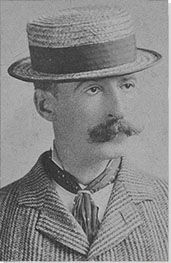Summary of Winslow Homer
One can imagine Winslow Homer walking the Maine shoreline captivated by the sublime power of the natural world and seeking to translate that experience onto his canvases through the bravura of his gestural brushwork. In these paintings, nature's power is both sublime and eternal, and coolly indifferent to the drama of the human condition.
The raw style of these later years was not an anomaly, but rather the distinguishing characteristic of Homer's overall career. He regularly approached subjects overlooked by professional artists of his time - rural schoolchildren, hunting scenes, or the lives of recently emancipated African-Americans - with a passion to tell a story. The uncompromising Realism of his style charted a new course for American Art, distinct from the stage-like settings of his European counterparts, while also dispensing with the idealized of the landscape or slick portraits of the upper classes which had previously dominated American painting. Instead, Homer documented the lives of average Americans in a straightforward and seemingly spontaneous style.
This look toward the defining qualities of American life and landscape not only captivated Homer, but also the later generations of American artists whom he inspired. The naturalism that marks Homer's long career, would provide a solid foundation for other icons of American painting, including Robert Henri, George Bellows, and later the modernist Marsden Hartley, each of whom made their own pilgrimage to the rocky shorelines of Maine. It was here that Homer and those who followed explored themes of mortality through images of the turbulent and seemingly eternal stretch of the northern Atlantic.
Accomplishments
- Winslow Homer's career as a painter began with his realist portrayals of the US Civil War. At first sent to the frontlines as a war correspondent, Homer documented the war through his engravings ranging from chaotic battle scenes to quiet moments of the soldier's everyday lives. These images came to visually define the war as "illustrated news" to a broad swath of the public in the Northern States. Later, Homer translated several of these drawings into a series of oil paintings that revealed the artist's insight into the life of Union soldiers.
- Throughout his long career, Homer captured the changing tides of American life and livelihood. Whereas his contemporary Thomas Eakins looked to the heroic personalities of athletes, doctors and professors, Homer sought instead to capture essential archetypes through the games of rural schoolteachers, to windswept land and seascapes, to the stout figures of fishing men and women.
- Although Homer has secured a legacy as the "quintessential American painter," two separate trips to Europe had a marked influence on the artist's approach to form and content. In Paris, he discovered the Realist canvases of Gustave Courbet, Jean-François Millet and the rising fascination with Japonism. Over a decade later, Homer traveled to Cullercoats, England where he was impressed by the lives of those men and women whose livelihood depended upon the sea.
- Themes of mortality repeatedly haunt Homer's oeuvre from his earliest Civil War paintings to his mid-career hunting series and, finally, his late ruminations on the sea. Often labeled as "heroic" and "masculine," Homer's deceptively simple compositions often presented precarious situations and served as poignant reminders of the fragility of life.
Important Art by Winslow Homer
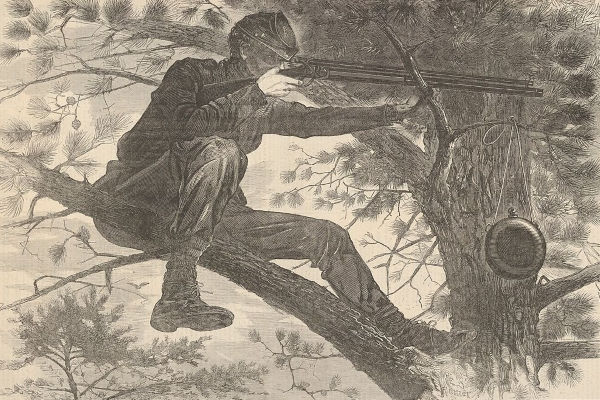
The Army of the Potomac - A Sharp Shooter on Picket Duty
After years of working as a freelance illustrator for Harper's Weekly, Winslow Homer was contracted by the publication to serve as a war correspondent. In sharp contrast to the light-hearted tone of Homer's early illustrations, his thoughtful portrayals of the US Civil War captured both the daily lives and moments of conflict which he experienced first-hand while visiting the Union soldiers on the front lines. Less obvious to modern viewers, are the changes in the technology and warfare shown in this engraving which was later the basis of an oil painting by the artist.
In The Sharpshooter, a young soldier sits perched on a sturdy tree branch, one imagines quite high from the ground below. The barrel of his rifle steadied against a smaller branch, while his position seems a bit precarious without any true grounding for his feet. Thick pine needles provide camouflage, while a hanging canteen suggests that the soldier has been in this position for quite some time and will probably remain there. What Homer has depicted was a new and devasting style of battle, the sharpshooter, made possible by advances in the design of the rifle. "I looked through one of their rifles once when they were in a peach orchard in front of Yorktown in April, 1862," Homer recalled. "The ... impression struck me as being as near murder as anything I ever think of in connection with the army & I always had a horror of that branch of the service." Instead of romanticizing heated scenes of battle, Homer depicted the impact of changing technologies in a straightforward, documentary manner devoid of the overt emotionality and heroic undertones so prominent in earlier depictions of war. As such, the notion of objectivity, so often associated with the Realist movement in America and Europe, finds true resonance with Homer's compositions.
Wood Engraving - The Metropolitan Museum of Art, New York
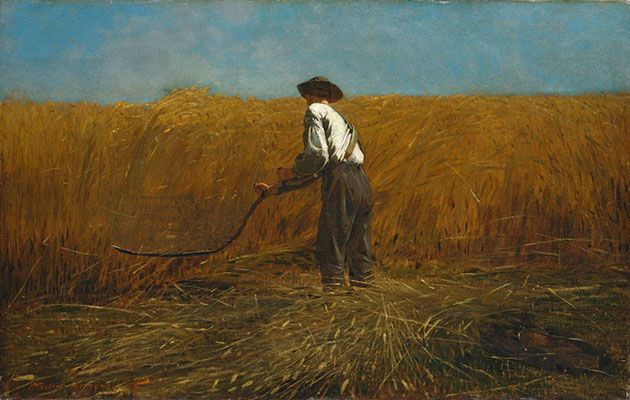
The Veteran in a New Field
Among the best-known of Homer's Civil War paintings, The Veteran in a New Field demonstrates the artist's profound understanding of the socio-historical moment in which he lived. A lone farmer harvests the seemingly eternal field of wheat with a single-bladed scythe. In the lower right corner, a Union soldier's jacket and canteen signal that this farmer is also a veteran of the recent Civil War. Painted shortly after the end of the devastating war and President Abraham Lincoln's subsequent assassination, The Veteran in a New Field is an early example of Homer's ability to weave subtle narratives into his paintings. The single-bladed scythe was, by this time, an antique tool and meant to evoke notions of "the grim reaper" and allusions to the casualties of war, with some of the major battles including Gettysburg, had been waged in what had formerly been working farms. Additionally, the peaceful disbanding of troops after the war was seen as an embodiment of a democratic ideal, with references to the Roman legend of Cincinnatus who similarly returned to his farm after leading Rome to victory over her enemies, a common point of reference in Homer's time. The combination of these elements has led historians such as H. Barbara Weinberg to consider the work, "a powerful meditation on America's sacrifices and its potential for recovery."
In terms of artistic strategy, Homer's painting seemingly blends Realist and Impressionist techniques in what would be described as a uniquely American style. The working figure of the soldier, painted in a relatively naturalistic style, suggests the hard labor of the solitary figure under the bright sun as he swings his tool across the wheat. By comparison, the wheat reads as Impressionistic, even though this painting dates before the beginnings of the Parisian style or Homer's trip to France. As Nicolas Cikovsky writes, "It had been Homer's practice to paint out of doors well before he went to France, so it cannot have been Impressionism ‑ even in the improbable event that he knew of it - that introduced Homer to the practice of open-air painting. It had been a central part of his artistic method virtually from his beginnings as a painter." The blending of naturalistic and impressionist styles in this and other works from the late 1860s are thought by many to have yielded a strong influence on American Impressionism, which, while focusing on different subjects, adopted some of the same loose brushstrokes.
Oil on canvas - The Metropolitan Museum of Art, New York
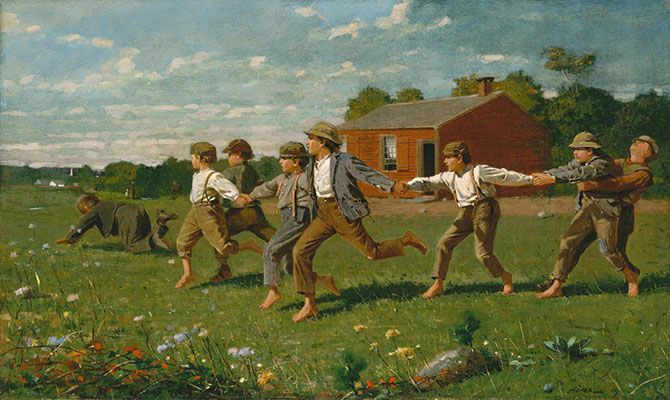
Snap the Whip!
One of Homer's most famous paintings presents modern viewers with a bit of a conundrum. It appears as a simple and idyllic scene with a line of young boys holding hands and running at top speed across a field of grass, rendered in an impossibly bright Kelly green speckled with wildflowers of various hues. In the background, a small red school house rests below a patchwork sky of blue and white. The painting, titled "Snap the Whip!" (1872) seems wistful, even nostalgic, and perhaps not what one expects in discussing one of the most esteemed American painters of the 19th century. Yet, even Homer's most idyllic paintings transcend nostalgia as one looks closer to find signs of poverty, such as the children's tattered and ill-fitting clothing and bare feet. Art historian Edward Lucie-Smith described in his text, American Realism, "Childhood and the life of children took on a special significance in America in the years following the Civil War, and these images symbolized the will to rebuild and to make a stronger and more vigorous nation." Subtle allusions to the lost generation of Civil War soldiers, the young widows left behind along with the hopes for the next generation provide the underlying narrative of these post-war works which focus on the lives of young teachers and their students.
Oil on canvas - The Metropolitan Museum of Art, New York
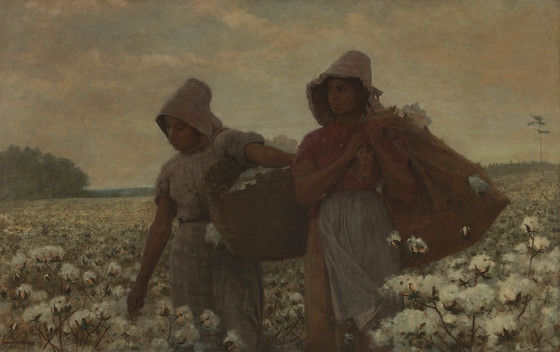
The Cotton Pickers
Winslow Homer's thoughtful composition, titled The Cotton Pickers, was completed just over a decade after the end of the US Civil War. In an era full of racist imagery, Homer returned to Virginia in the 1870s to begin work on a series of paintings depicting the lives of those newly freed from slavery but still struggling against the obstacles of entrenched bigotry. Instead of caricatures, he depicts quiet moments in the everyday lives of the newly freed African-Americans. There is no underlying moralistic tale or narrative storyline that artist presents, but in a manner similar to Veteran in a New Field and Snap the Whip!, Homer creates the impression of an observed moment in time.
Two women stand in an expansive field of cotton during harvest season, the efforts of their daily toil evident in the heavy load each carries. The monumental scale of the two figures is reminiscent of Jean-François Millet's influence, as is the rose-colored twilight sky the French Realist often employed in his sympathetic depictions of rural labor. The time of day becomes a metaphor for the era, as Homer painted this series during the closing years of the Reconstruction Era, with the removal of federal troops from the South soon to follow with the passing of The Compromise of 1877. Yet, Homer is not didactic in his approach to these genre paintings.
Although painting in a symphony of pastel hues, offset by the soft white bulbs of cotton, this painting does little to provide reassurance for the fate of these women. Instead, in this and many of works of the era, Homer leaves the fate of the characters to find resolution in the minds of the viewer.
Oil on canvas - Los Angeles County Museum of Art
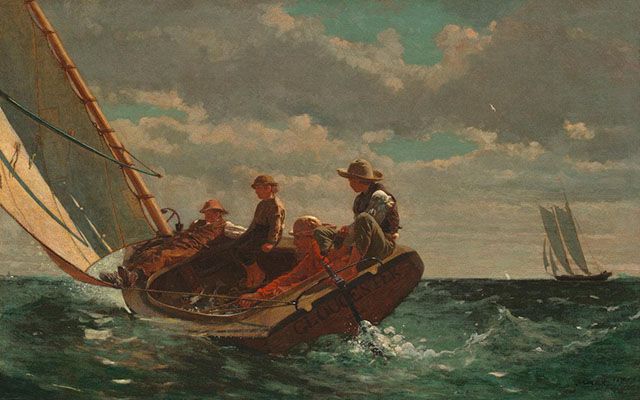
Breezing Up (A Fair Wind)
Exhibited to critical praise, Breezing Up (A Fair Wind) shows a working father and his three sons on a catboat in the afternoon. Similar to a modern-day snapshot, the fishing boat seems about to speed out of view, the top of its mast already cropped out of the painting. Contrasting the sense of determined movement of the small craft in the foreground, a large sailboat leisurely crosses in the far background. Like his earlier works, Homer realistically depicted the scene, without a touch of sentiment.
The stern look on the father's face as he steers the small boat is contrasted by the youthful postures of the his sons, lost in their own thoughts, not quite attuned to the pressures of the adult's world. Perhaps this subtle contrast helped make the work one of Homer's most-loved depictions.
This simple painting, which appears so quintessentially American in tone demonstrates the influence of his brief stay in France in the previous decade. The subject reflects concerns he shared with the Realist painters of France who similarly put the working figures in the immediate foreground of the composition. There is also a shift in Homer's gestural brushstrokes, which became increasingly confident after his trip to Paris, most notably in the sky and the sea. Finally, the compositional structure reveals a debt to the lessons of Japonism - the juxtaposition of extremely close-up objects against those in the deep background are seen from a slightly elevated position. In both style and subject, Breezing Up anticipates themes that will resurface and dominate his oeuvre after his second trip to Europe in 1881.
Oil on canvas - The National Gallery of Art, Washington DC
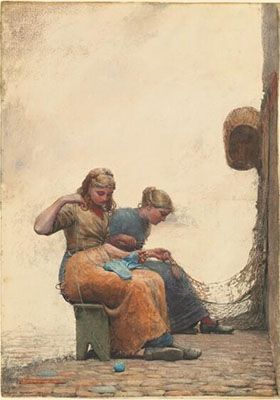
Mending the Nets
Homer often turned to watercolor when he traveled, including during the period he spent in the fishing village of Cullercoats, England. Originally titled, "Far Away from Billingsgate," this watercolor was later renamed Mending the Nets, after Homer scratched away the scenery behind the two engaged in the title activity. The simplicity of the local lifestyle appealed to his interest and gave him a new selection of genre scenes loosely related to his increasing interest in marine scenes. The high level of detail in the work, especially in the figures' hair and the fishing net, evidences Homer's great skill with the difficult medium. The women wear tattered clothes and are focused on their work, a sharp contrast to Homer's earlier compositions of genteel women often engaged in recreational activities.
It was the style, more than the subject, of Homer's English period that seems to have caught his critics off guard, with one noting in the New York Times, "They are English in method and style. One needs to read the signed named before believing that the maker of those British watercolors is the same who used to rouse the wrath or admiration of the critics by his quaint conceits, his bald oddities, his lovely transcripts of scenes that only he knew how to depict." The historian Nicolas Cikovsky credits the sparsity of style "in order to achieve the effect of figures against a plain, unlocalized background" to the influence of Ancient Greek relief sculpture, crediting this newfound sense of compositional space to the metopes of friezes of the fragments of the Parthenon (also known as the "Elgin Marbles") Homer would have seen at British Museum in London.
Watercolor and gouache over graphite - The National Gallery of Art, Washington DC
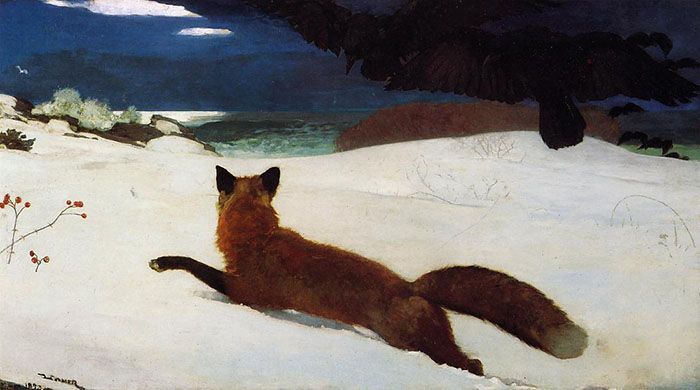
Fox Hunt
In this painting, the influence of Japanese prints, first seen on his Paris trip in 1876, manifests.
Homer's largest canvas, Fox Hunt is a strong example of the subjects the artist focused on in the 1890s as he largely turned away from depictions of men and women working in and interacting with nature. Instead, the artist focused on representing the natural world exclusively. Here, he has painted a dramatic winter scene with a starved fox attempting to survive an attack by a murder of hungry crows. The crows loom large overhead while the fox is shown mid-stride, although clearly slowed by the deep winter snow - the whole lending the canvas a sense of sublime urgency. The traditional roles are reversed in this scene, for the fox who usually hunts here becomes the hunted. The paw of the struggling creature reaches forth, pointing to the only sign of vegetation, bright red berries, a poisonous breed, starkly placed against the cold white snow. An allusion, perhaps to one anticipated outcome of this scene. However, the sharp diagonal created by the fox, matched by the artist's signature in the lower left corner, suggests a sense of motion for the animal and allows the viewer to determine the conclusion to this dramatic scene.
Like his earlier Breezing Up (A Fair Wind), the careful compositional arrangement of Fox Hunt shows Homer's debt to Japanese woodblock prints. The strong diagonal lines of the composition, the juxtaposition of objects both near and far, and the large flat areas of color are all indicative of this influence. Additionally, the unusual vantage point, slightly above and looking down, is another technique often associated with the earlier prints. Here, it effectively puts the viewers nearly in line with the hovering crows, while emphasizing the struggling fox as the primary focus of the viewer's attention. The painting was immediately successful; purchased by the Pennsylvania Academy of the Fine Arts shortly after it was completed in 1893. It was the first painting by Homer to enter a public collection.
Oil on canvas - Pennsylvania Academy of the Fine Arts, Pennsylvania
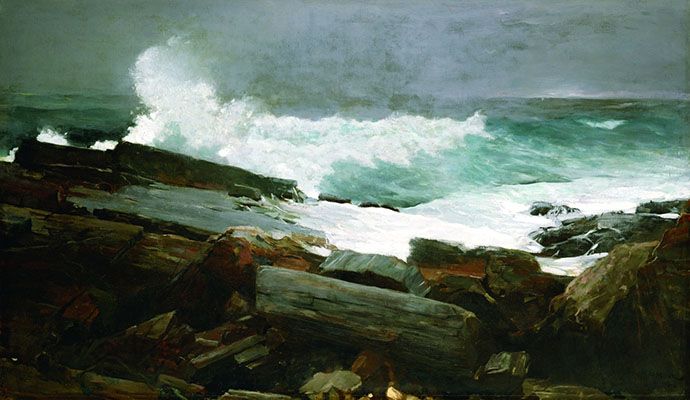
Weatherbeaten
Homer's visionary seascapes suggest a departure from his Realist inclinations into the Romantic territory of the sublime. Painted with the loose brushstrokes he had cultivated since the 1870s, Weatherbeaten depicts a prevalent subject of his late career: the rocky coastline of Maine on a stormy, overcast afternoon. This lonely vision of a desolate sea excites the viewer's sensibilities. Although based on the natural views of the landscape, Homer removed elements of the natural scenery in order to emphasize a sense of the eternal reach of the sea. One can imagine the sound of the waves, the smell of the salty water, the texture of the weather-beaten rocks, and the cool mists rising from the crashing waves.
Works such as these offered an anchor to an American public during a period where the effects of rapid industrialization provoked great economic change and social anxiety. In place of the urban and industrial, the viewer is captivated by the eternal cycles of the natural world. Like his predecessors associated with the Hudson River School earlier in the century, Homer removed the increasing signs of tourism to depict an image of uninhabited nature. Stripped on any non-essentials, Homer's biographer, William Howe Downes, described the impact of this painting in 1911, writing: "Reality is made more real; we are acutely alive when brought into its presence. Our horizons expand...we take deeper breaths."
Oil on canvas - Portland Museum of Art, Maine
Biography of Winslow Homer
Childhood and Education
Winslow Homer was born to Charles Savage Homer and Henrietta Benson Homer in Boston, Massachusetts, the middle child of three sons. The family moved when young Winslow was six years of age to the nearby rural town of Cambridge. His mother was an amateur watercolorist who taught her artistic son the rudiments of her craft; their shared affinity for the arts fostered a close relationship that lasted throughout their lives. His father, on the other hand, was a largely-failed businessman and, in the words of art historian and curator Nicolai Cikovsky, an eccentric in "behavior and appearance." He was, nevertheless, supportive of his son's artistic ambitions. As Cikovsky details in the exhibition catalogue for the comprehensive 1995 exhibition at the National Gallery of Art in Washington, D.C., "He also encouraged his son's 'leaning towards art' by acquiring for him, on a business trip to England, such resources for artistic self-help as 'a complete set of lithographs by Julian [sic] - representations of heads, ears, noses, eyes, faces, trees, houses, everything that a young draughtsman might fancy trying to make his hand at." Additionally, it was his father who arranged the hopeful artist with an apprenticeship to an acquaintance John H. Bufford, a prominent commercial lithographer in Boston, when Winslow reached 19 years of age.
Although this period represents the closest experience resembling any formal training, creating illustrations for popular sheet music, Homer would later describe these two years as merely a "treadmill existence." At the end of his apprenticeship in 1857, Homer swore never to work for anyone again, opened his own studio in Boston and established a successful freelance career as a commercial illustrator. Although Homer quickly gained stature, creating works for magazines like Ballou's Pictorial and Frank Leslie's Illustrated Newspaper in Boston, as well as the influential Harper's Weekly in New York, he would soon reveal his true ambition: to become a painter.
Accordingly, in 1859, Homer moved to New York which was by then a major center of both publishing and artistic activity, where fierce rivalry between the legacy of the older generation of Hudson River School artists confronted the new trends imported from Europe. Shortly after establishing his studio in the city, Homer enrolled in classes at the National Academy of Design in the fall of that same year. As Cikovsky details, "Sometime early in 1861, he took a month of lessons from Frederick Rondel (a Boston artist whom he may already have known), who once a week, on Saturdays, taught him how to handle his brush, set his palette, & etc." Homer took additional classes at the academy in 1863, but credits his primary instruction, not to a specific mentor, but the study of nature. For the young artist, Europe beckoned as the next logical step to hone his developing skills, but the escalation of the US Civil War put such plans on hold.
Early Career
Winslow Homer's early career as a freelance illustrator brought him into direct contact with the realities of the Civil War. Within six months of the war's outbreak, Harper's Weekly assigned Homer to cover the war from the front lines, which proved a turning point in his personal and artistic development. During Homer's multiple visits to the camps of the Northern troops, he produced numerous studies for engravings ranging from genre scenes to crowded scenes of conflict. Yet, it was his nuanced depictions of the everyday lives of the common soldiers which dominate his oeuvre from this period. These sketches later formed the basis of his commercial illustrations and today also provide a unique view into the changing technologies of modern warfare, most notably in The Army of the Potomac - A Sharp Shooter on Picket Duty (1862). During this time, Homer also made his "professional debut" as a painter with great success at the annual exhibition at the National Academy of Design in 1863 with two paintings, Home, Sweet Home and The Last Goose at Yorktown, both focused on the daily life of Union soldiers.
After the war's end, Homer's wartime sketches continued to inform a series of paintings, most notably Veteran in a New Field (1865) and Prisoners on the Front (1866), which secured his reputation as an artist and remain among his best-known paintings to this day. These works secured his artistic reputation in New York with the latter also chosen to represent the United States at the Exposition Universelle in Paris in 1866. Even with this success, Homer continued to make commercial works until 1875, at which point oil painting and watercolor became Homer's primary occupations.
Mature Period
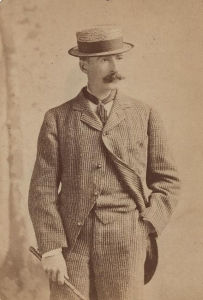
In 1867, Homer traveled with his painting to France for the first of his two trips to Europe, and lived in Paris for nearly a year. The young American's stay in France coincided with exhibitions of works by Realist artists like Edouard Manet and Gustave Courbet. However, as Cikovsky points out, Homer found greater inspiration in Jean-François Millet and The Barbizon School, a landscape-oriented movement that also gained popularity in America in the 1860s. During his stay, Homer would also have seen the pre-Impressionist paintings by Claude Monet and Auguste Renoir who seemed as equally compelled by the natural effects of light as their American counterpart.
Upon returning to the United States, surprisingly, Homer did not exhibit new paintings from his time abroad, yet he did show, in the words of historian Margaret C. Conrads, "Prisoners on the Front, the canvas that had single-handedly catapulted him to fame in 1866," which again went on view at the National Academy of Design.
In fact, there was a sense of nostalgia and innocence mixed in with a distinctly American manifestation of modern, democratic ideals that characterized the paintings created by Homer upon his return. The style of his work, even in this early period, irritated critics of his day, some of whom described it as "unfinished," and has long frustrated anyone seeking to create a lineage between Homer and earlier masters in either the United States or Europe. A well-known saying by Homer encapsulates his goal of artistic independence: "If a man wants to be an artist, he must never look at pictures." Accordingly, Homer readily continued to paint images of rural American life in his unique style, including a series of works that depicted scenes of rural schoolchildren run by young school mistresses and insightful genre scenes of African Americans, without adopting the aesthetics or urban inclinations of the "advanced" trends in French painting.
Homer's work gained traction during the 1870s, and during the summer of 1873 while in Gloucester, Massachusetts, Homer began to devote serious attention to painting with watercolors for which he remains the greatest American painter associated with the medium through today.
Throughout the steady rise of his popularity, critical reception of his work remained mixed. Of his works in the 1876 Centennial Exposition, one independent critic wrote, "We frankly confess that we detest his subjects...he has chosen the least pictorial range of scenery and civilization; he has resolutely treated them as if they were pictorial," while a write up in The New York Tribune praised his originality: "There is no picture in this exhibition, nor can we remember when there has been a picture in any exhibition, that can be named alongside this."
In 1878, Homer was again included with a group of artists selected to represent America at the Exposition Universelle in Paris where, as Margaret C. Conrad explains: "European critic's responses reiterated the commonly accepted hallmarks of Homer's Americanness: his subjects, spirit of originality, simple-heartedness, honesty (though considered gauche by some), truth of sentiment and treatment, and strong local character."
Although usually described as a private person, Homer's time in both France and New York included camaraderie with his fellow artists. In the later 1870s, he participated in The Tile Club, an artistic society founded in 1877 responding to the burgeoning popularity of decorative arts in the United States. The group of artists, including painters William Merritt Chase, Arthur Quartley, John H. Twachtman and sculptor Augustus Saint-Gaudens, frequently met, went on painting excursions, and would each contribute paintings on an 8-by-8-inch tile, hence the club's name. While active with this group, including hosting dinners at his studio, these relationships did not seem to last beyond Homer's membership in the club, during which he earned the nickname, "The Obtuse Bard," perhaps providing some insight into his character.
Around 1880, Homer became markedly more reclusive, removing himself from urban social life for a quieter life in small towns, moving to an island in Gloucester Harbor for the summer. Some speculate this had to do with a series of heartbreaks or other such emotional turmoil, though such conjecture remains impossible to confirm as Homer kept his private life quite guarded. As he reportedly once told to a potential biographer, "It would probably kill me to have such a thing appear - and as the most interesting part of my life is of no concern to the public I must decline to give you any particulars in regard to it." Regardless, this shift in environment had a significant impact on the subject-matter of his works, which grew increasingly dramatic and even brooding during this period.
Later Period
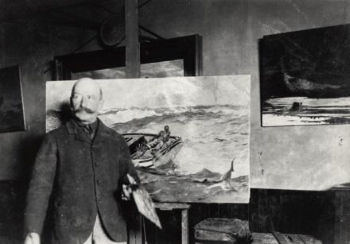
The first place Homer went after leaving the hustle-and-bustle of New York was the remote fishing village of Cullercoats in Northumberland, England, where he lived from 1881 to 1882. In his essay titled A Process of Change, Franklin Kelly, a historian of American and British art, described, "Virtually every writer who has had anything to say about Homer since 1882 has regarded the trip to England as a critical turning point in his career, one demarcating his early years, with all their promise, from his mature career, when he would bring to his art a new level of intensity and purpose." His subjects in Cullercoats, often portrayed in watercolor, shifted toward the working classes, most often the fishermen and women whose lives were both separated and united by the sea. Homer simultaneously captured the atmospheric fog-lined shore while depicting scenes in an unemotional manner that leads art historians to read the works from this period as representations of the daily heroism of common laborers. Others, such as English writer and art critic Edward Lucie-Smith look to an objective "photographic influence" in Homer's work with "an emphasis on simple, static and often silhouetted forms." When he returned to the United States and exhibited these works in New York, critics noted the differences between these and his earlier paintings: "He is a very different Homer from the one we knew in days gone by," now his pictures "touch a far higher plane...They are works of High Art."
Although Homer would continue to show his work in New York for the rest of his career, he chose not to live in the city upon returning to American. Instead, as Helen S. Cooper notes, "The need for isolation that had led Homer to spend over a year and a half in Cullercoats remained with him in America. He found an appropriate environment in Prout's Neck, a rocky peninsula on the coast of Maine, ten miles south of Portland." The move north was first made by his younger brother Arthur, who was the first to visit the region on his honeymoon in 1875, and continued to summer there in the following years. In 1883, the family invested in property, including Winslow who had intended to likewise summer at the property but upon the death of his mother the following year, took up permanent residence in a small cottage where he also set up his studio.
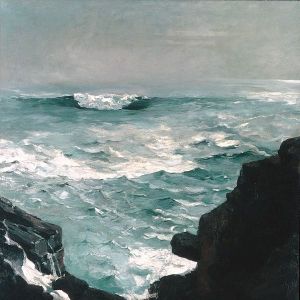
The artist had visited the secluded region for nearly a decade before relocating to spend the rest of his life in Prout's Neck, where his closest relationships were his brother Charles, and his sister-in-law Mattie. Homer bought the carriage house of the main house which belonged to his brother, where he built his artist studio with a view looking beyond the rocky cliffs to the sea. During this period, his most famous paintings might suggest a life of solitude and forebearance. However, Homer is known to have regularly traveled far from the frigid northern shores of Prout's Neck for the warmer climes of Bermuda, the Bahamas, and Florida during the winter months, capturing the distinct aura of the tropical climate in a series of watercolor paintings and sketches. However, upon return to his studio set above the rocky seaside cliffs, Homer would return to his relentless explorations of the sea.
At the age of 74, Winslow Homer passed away in Prout's Neck in 1910.
The Legacy of Winslow Homer
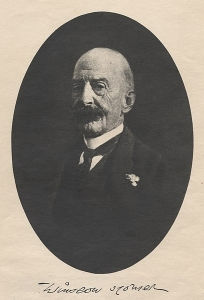
Winslow Homer is widely considered one of the foremost American painters of the nineteenth century. His work figured importantly in developing an American artistic sensibility at a time when European influences were the topic of much debate by artists and critics in the United States. His resolute independence was a source of influence for those of his own time. As noted by art historian Matthew Baigell in A Concise History of American Painting and Sculpture, "Homer and Eakins transformed genre painting and portraiture into strong statements of personal sensibility and in their late works discovered an America that impressionist pleasantries and American renaissance escapism entirely overlooked." Homer's influence is also evident in the coarse naturalism of the succeeding generations of Realists, known as the Ashcan Painters, from Robert Henri to his students, including George Bellows, George Luks and John Sloan.
Conversely, Homer's visions of the sea served as inspiration for the transcendentalist painter Rockwell Kent who, like Henri and Bellows, travelled to the rocky coast of Maine to paint from the same terrain the inspired his hero. Kent's unpopulated landscapes, including wintry scenes of the Maine Coast, are noted for the formal qualities that tie his work to Homer. In the words of J. Nilsen Laurvik, director of the Palace of Fine Arts, San Francisco, Kent was "a worthy successor to the master of Prout's Neck, whos rugged, rock-ribbed coast he has depicted with forthright simplicity and directness that has something of the stark actuality and bitter tang of the sea itself."
The influence of Winslow Homer continued into the 20th century, particularly among artists who largely rejected the European inspired trends of abstraction and continued to pursue a distinctly American voice in their art. Among the American Regionalists, the vision of Homer found greatest resonance with the realist paintings of Edward Hopper whose urban landscapes match the eerie silence of Homer's desolate seascapes. Somewhat surprising is Homer's influence on those artists who more readily identify with the influences of European abstraction in the early 20th century such as Marsden Hartley. Both Hopper and Hartley took multiple trips to the Maine coast, repeating the pilgrimage first taken by Henri and Bellows. But where the influence of Homer on the succeeding realists is overt, Hartley sought to fuse the two seemingly diverse approaches to create a modern regionalist style.
It is fitting that for an artist whose long career explored various media, from printmaking to watercolor to oil painting, that his influence would be equally diverse. Both Homer and Hopper began their career as illustrators, and Homer's direct approach also influenced the style of illustrators such as Howard Pyle and his student N.C. Wyeth who even named his studio "Eight Bells" after an eponymous painting by Homer. The admiration for the 19th-century master passed to his children, perhaps most notably Andrew Wyeth who shared Homer's affinity for wintry landscapes.
Influences and Connections

- Eugene Benson
Useful Resources on Winslow Homer
- Winslow Homer: An American VisionOur PickBy Randall C Griffin
- Reckoning with Winslow Homer: His Late Paintings and Their InfluenceBy Bruce Robertson
- Winslow Homer WatercolorsBy Helen A. Cooper
- Winslow Homer (Exhibition catalogue from the NGA)Our PickBy Nicolai Cikovsky Jr.
- Winslow Homer, American Artist: His World and His WorkBy Albert Ten Eyck Gardner
- Winslow HomerBy Lloyd Goodrich
 Ask The Art Story AI
Ask The Art Story AI